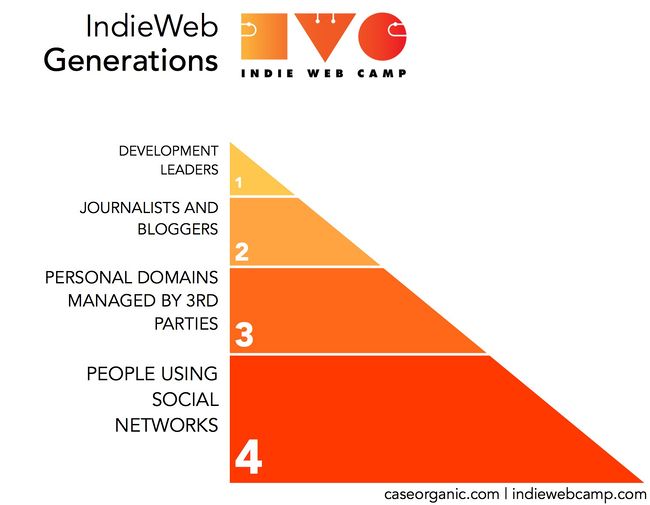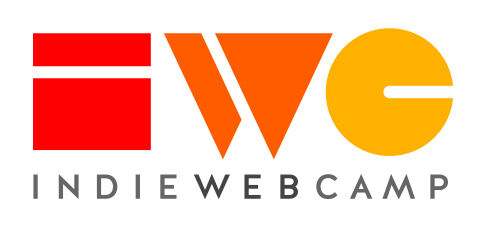generations
Generations was a 2014-era summary of a spectrum of potential IndieWeb adopters (beyond the oversimplified developer/user dichotomy) in a series of clusters that were expected to progressively adopt the IndieWeb for themselves and help onboard others; subsequently the community grew, both across generations & in other ways, and is working on replacing it with something more inclusive and up to date. Each generation was expected to lower barriers for adoption successively for the next generation.
Content below this point is preserved for historical reasons.

The concept of a Generation allows us to group the experience of a group into a cluster that we can build tools for and create language to encourage growth. The term "Generation" does not have to be a permanent name but it is a good way to begin organizing thoughts about how we explain the value of the IndieWeb to people with different backgrounds.
Generational Inertia
Note that it's going to be very difficult for Generation 1 IndieWeb group to understand how Generation 4 IndieWeb group sees terms like DNS, Hosting, Domain Registry, etc. Each Generation should be best at explaining IndieWeb to the next Generation. Each Generation should focus on filling in the gaps between one generation to the next.
Many experienced web developers that are new to the IndieWeb often wonder how the IndieWeb will be possible to join by someone who has never registered a domain before. We suggest an incremental approach (stair step model) where we can slowly iterate towards larger groups that have less core experience with web development and are more silo oriented in their experience of the web.
Bridging the Generations
Ryan Barrett's Bridgy is literally a bridge from Generation 1 to Generation 2 understanding and adoption of the IndieWeb because it allows Generation 2 to own their content on their own site, post to a silo, but also get the conversation from the silo posted back on their own site. This is an even better outcome.
Cost of Upkeep
When you own something there's a burden of upkeep. Many people are running WordPress and they're unaware the cost of upkeep. This is an aspect that will need to be addressed for Gen 2, 3, and 4. When you make your own tech or use 3rd party tech there's still a bit of bit rot that happens.
From discussion with Ariel Waldman and Matt Biddulph on the IndieWeb: Matt Biddulph: "I have consciously divested myself of running certain technologies and have become flexible with adapting to what makes sense to use at a certain time".
IndieWeb Generations
| Generation 1 | Generation 2 | Generation 3 | Generation 4 |
| Capable of building a CMS, custom blogging software, understands SSL, git, SSH, APIs, domain registrars, DNS, nameservers, communicating over IRC, and editing wikis, and is comfortable running a server to host their own content, and knows at least one basic web-based programming language. Comfortable with lengthy documentation. | Understands cPanel, Softaculous, Fantastico, etc. has a domain name and blog. | Has a domain but the content is hosted by a 3rd party on Wordpress.com, Tumblr, etc and can register a domain and follow a tutorial to point Nameservers at the proper address. | Has never purchased their own domain name and has only used 3rd party software. Easily turned off by industry jargon like DNS, Hosting, Servers, silos, Domain Registrars. Never bought a domain name before or run a personal site. Has never seen a server, cPanel or Nameserver prompt. |
Generation 1 IndieWeb
Introducing Gen1 to the IndieWeb:
- Demo the basic concepts of POSSE, backfeed, Webmention and Microformats and the purpose of each.
- Show individual some example best practices for user experience and stress that homespun posting interfaces do not need to be professional looking or perfect as they're use
- Stress the IndieWeb principles like data ownership, selfdogfooding, and show before tell. Encourage individual to "scratch their own itches", create and iterate on their own site.
- Point individual to #indiewebcamp on IRC and link to documentation on the Wiki for further exploration and engagement.
- Encourage individual to attend or start a Homebrew Website Club.
Generation 2 IndieWeb
Introducing Gen2 to the IndieWeb:
- Demo basic concepts of POSSE, Bridgy, Webmention and Microformats.
- Show the value of the IndieWeb to this generation by showing demos of backfeed technologies like Bridgy.
- Discuss existing tools and CMS that can be configured relatively quickly.
- If individual is running WordPress, discuss IndieWeb WordPress plugins individual can install to get 'IndieWebified'.
- Encourage individual to attend or start a Homebrew Website Club.
For most journalists the pressing need is a one-click installation of a CMS such as WordPress that would set them up properly, with a wizard to help them cast the spells of hooking up to their social media accounts and bringing all those interactions back home. Without it, the number of IndieWeb-enabled journalists is likely to remain rather low. This could potentially be the basis of a specialised hosting service.
Some technically-minded journalists have embraced the IndieWeb. Dan Gillmor wrote about his experiences learning about the IndieWeb and then about putting it to work on his WordPress-powered site. That article was also POSSEd to Slate. The page Indieweb for Journalism has been set up to provide some ideas and motivation for this segment of users.
Technically minded educators using the web and digital humanities philosophies can be excellent gateways for expanding IndieWeb reach. Movements like A Domain of One's Own can be incredibly useful as well. The page Indieweb for Education has been set up to provide some ideas and motivation for this growing segment of users.
ToDo: Add user stories from Scott Jenson on the barriers getting basic IndieWeb methods set up on their site and what their breakthroughs were.
Super vocal bloggers who are very frustrated are more likely to understand the value of IndieWeb concepts early on.
Note: Events and Indie Event RSVP should be added during the transition from Generation 2-3.
Nota Bene: selfdogfood is a potentially offputting term for 2nd and subsequent generations. We should come up with something that sounds less unpleasant.
Brainstorming
How can Generation 1 or Generation 2 make it easier for those who follow in their footsteps?
- There are some interesting thoughts compiled here on Gen2 usage: [1] [2]
- Services like micro.blog provide a simpler hosted solution that allow larger numbers of Gen2/Gen3 users to have a reasonable IndieWeb presence with little to no coding experience and at a low cost. Many users interested primarily in the platform have been introduced to the idea of IndieWeb and have built or modified their pre-existing sites to conform to a larger number of building-blocks.
 Chris Aldrich has proposed writing a book as part of NaNoWriMo 2017 about the IndieWeb and getting set up using WordPress. It will be geared toward Gen2+ users and lay out onboarding in a step-by-step or "cookbook" manner. Think "IndieWeb for Dummies".
Chris Aldrich has proposed writing a book as part of NaNoWriMo 2017 about the IndieWeb and getting set up using WordPress. It will be geared toward Gen2+ users and lay out onboarding in a step-by-step or "cookbook" manner. Think "IndieWeb for Dummies".
Generation 3 IndieWeb
Introducing Gen3 to the IndieWeb:
- This is possible but Gen2 needs to take precedence first so that the experience is better for Gen3's.
Example of a Generation 3 individual's reaction to IndieWebify.me:
May help to set expectations and figure out ways to reach out to this crowd when we get to that point.
Generation 4 IndieWeb
Know that even getting a Generation 4 person to associate a custom domain name with a Tumblr account requires signing up for a domain name, pointing Nameservers to the proper address, and finally adding some HTML to the page. It is very important to understand that this generation is easily overwhelmed by any software or user interfaces not made for the general public.
There are many unanswered questions on how a Generation 4 might do this without Tumblr. Hosting, the ides of a public_html folder, using a hosting company's interface to edit the HTML of a personal website, using Bootstrap or Jetstrap, installing Wordpress, downloading an FTP client to edit HTML, is quite complex for someone new to owning their own domain.
Ideally one would get a full understanding of Git and use something like Sublime Text to edit code, but this is truly above and beyond.
Introducing Gen4 to the IndieWeb:
- Introducing Gen4 to the IndieWeb is not yet reasonable at this time.
Brainstorming
Ideas for improving onboarding for future generations
IndieWebCamp Sessions
A fuller picture of various ideas can be found on the following pages:
- IndieWebCamp Berlin 2016 Onboarding and Personas Session 1
- IndieWebCamp Düsseldorf 2017 Onboarding and Personas Session 2
- IndieWebCamp Nuremberg 2017 Onboarding and Personas Session 3
- IndieWebCamp Summit 2017 IndieWeb Refresh session
- IndieWebCamp Summit 2017 Site-Refresh follow up session
Generations Examples
To get an idea of how various generations think, feel free to self-identify below with any additional thoughts about your experience(s) and links to related posts. Please also add users in later generations who may not be on the wiki to indicate the potential level of engagement the movement may be at presently.
Generation 1
 Tantek Çelik
Tantek Çelik Aaron Parecki
Aaron Parecki Ryan Barrett
Ryan BarrettDavid Shanske
 Matthias Pfefferle
Matthias Pfefferle- Add yourself here… (see this for more details)
Generation 1 / Generation 2
Users who fit somewhere in the margins between Generation 1 and Generation 2
 Chris Aldrich self-identifies more closely with Generation 2, but has enough programming, technical experience, and CMS experience to be comfortable with Generation 1 work and discussion.
Chris Aldrich self-identifies more closely with Generation 2, but has enough programming, technical experience, and CMS experience to be comfortable with Generation 1 work and discussion.Khürt Williams is a former LAMP stack web developer who hasn't coded for the web in a long time but identifies with Generation 1.
- Chris Beckstrom loves DIYing, and is comfortable on the command line, loves vim, and enjoys configuring new web services and toying with CSS. Perhaps that puts him between gen 1 and 2.
- Add yourself here… (see this for more details)
Generation 2
Dan Gillmor† (Journalist)
 Aaron Davis† (Educator) My #IndieWeb Reflections
Aaron Davis† (Educator) My #IndieWeb Reflections Rob Fairhead
Rob Fairhead Kimberly Hirsh
Kimberly Hirsh- Fred Wilson (VC)
- Add yourself here… (see this for more details)
Generation 2 / Generation 3
Users who fit somewhere in the margins between Generation 2 and Generation 3
- Add yourself here… (see this for more details)
Generation 3
- Add yourself here… (see this for more details)
 Jean MacDonald: attended the IndieWeb Summit in Portland, 2017 and 2018; co-organized IndieWebCamp Austin 2020; community manager at Micro.blog; freelance web designer 1997 - 2006; web design instructor, Pacific Northwest College of Art, 1999 - 2004.
Jean MacDonald: attended the IndieWeb Summit in Portland, 2017 and 2018; co-organized IndieWebCamp Austin 2020; community manager at Micro.blog; freelance web designer 1997 - 2006; web design instructor, Pacific Northwest College of Art, 1999 - 2004.
Generation 3 / Generation 4
Users who fit somewhere in the margins between Generation 3 and Generation 4
Emma Hodge - attended IndieWebCamp NYC 2016, got help with registering a domain name, setting up static hosting on GitHub, and has updated her site http://emmahodge.org/ since! As well as co-organized IWC NYC2 2016, IWC NYC 2017!
- Add yourself here… (see this for more details)
Generation 4
- Add yourself here… (see this for more details)
† Not on the wiki when the example was added to the list
Criticism
This model was created from an anthropologic point of view, looking at the system from the outside and describing the people in it. This kind of model is not usually intended for people to self-identify within the model. We have seen several instances of the use of this terminology causing problems [see some of the citations in criticism]. It may be better to use an alternative model that is more appropriate for people to self-identify within.
See Also
- onboarding
- getting started
- personas
- use case
- Tom Sawyering
- Tutorials
- [@iamJeffPerry]: "Diving into this Indieweb stuff with no coding knowledge was actually easier that I thought." (http://twtr.io/1XKtitx9KRs)
- https://www.forbes.com/sites/danschawbel/2013/12/17/geoffrey-moore-why-crossing-the-chasm-is-still-relevant/
- https://chat.indieweb.org/meta/2018-07-01#t1530418649464700
- 2018-07-17 Laura Kalbag: Beyond my means
- 2018-03-23
 Manton Reece: IndieWeb generation 4 and hosted domains
Manton Reece: IndieWeb generation 4 and hosted domains - “the “self-made” webmaster who builds a self-contained website, independent of the centralized aggregate (and by extension, The Man), using home-grown tools, falls very much in line with the values of the American Dream.” Diversity on Micro.blog, from a minority viewpoint.
- Another (perhaps more critical) view of technology adoption “generations”: https://twitter.com/andybudd/status/1214571469516214275
- "The first generation of Web people were the ham radio tinkerers.
The second generation were attracted by its cultural significance.
The third generation saw it as a business opportunity.
The fourth generation saw it as a way to amplify their personal brand." @andybudd January 7, 2020
- "The first generation of Web people were the ham radio tinkerers.
- https://www.threads.net/@tommysiegel/post/C56AWTcOX-L/ — comic with heading "Being a Millenial: A Brief History" and a 2x2 grid of four comics panels showing a hipster Millenial in each, in the first thee pointing to a new social media service icon saying "This is for me, a young person" in order: MySpace, Facebook, Instagram, and then looking very old & sullen wearing a gray t-shirt in the fourth panel silently staring at a TikTok logo.
